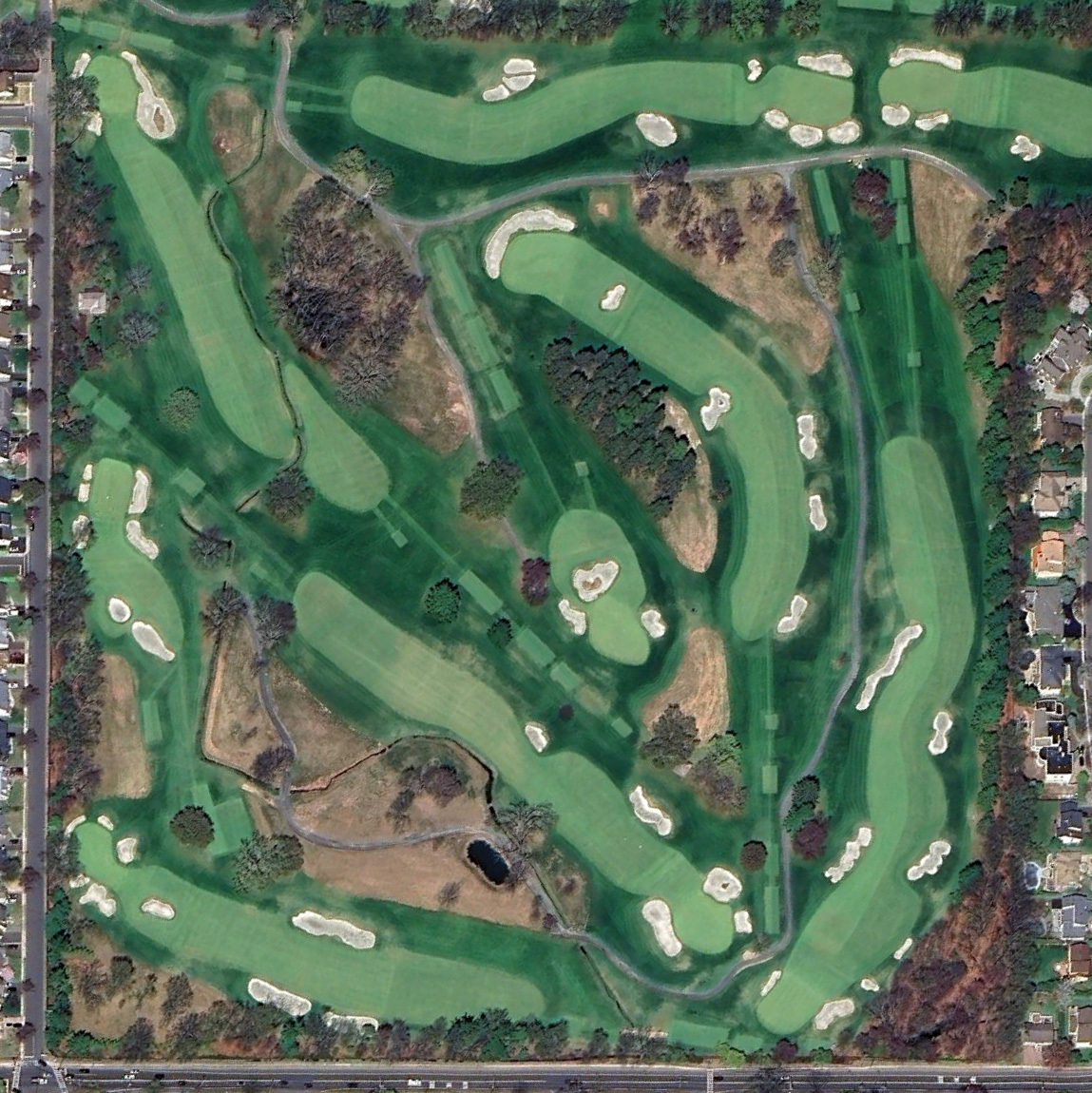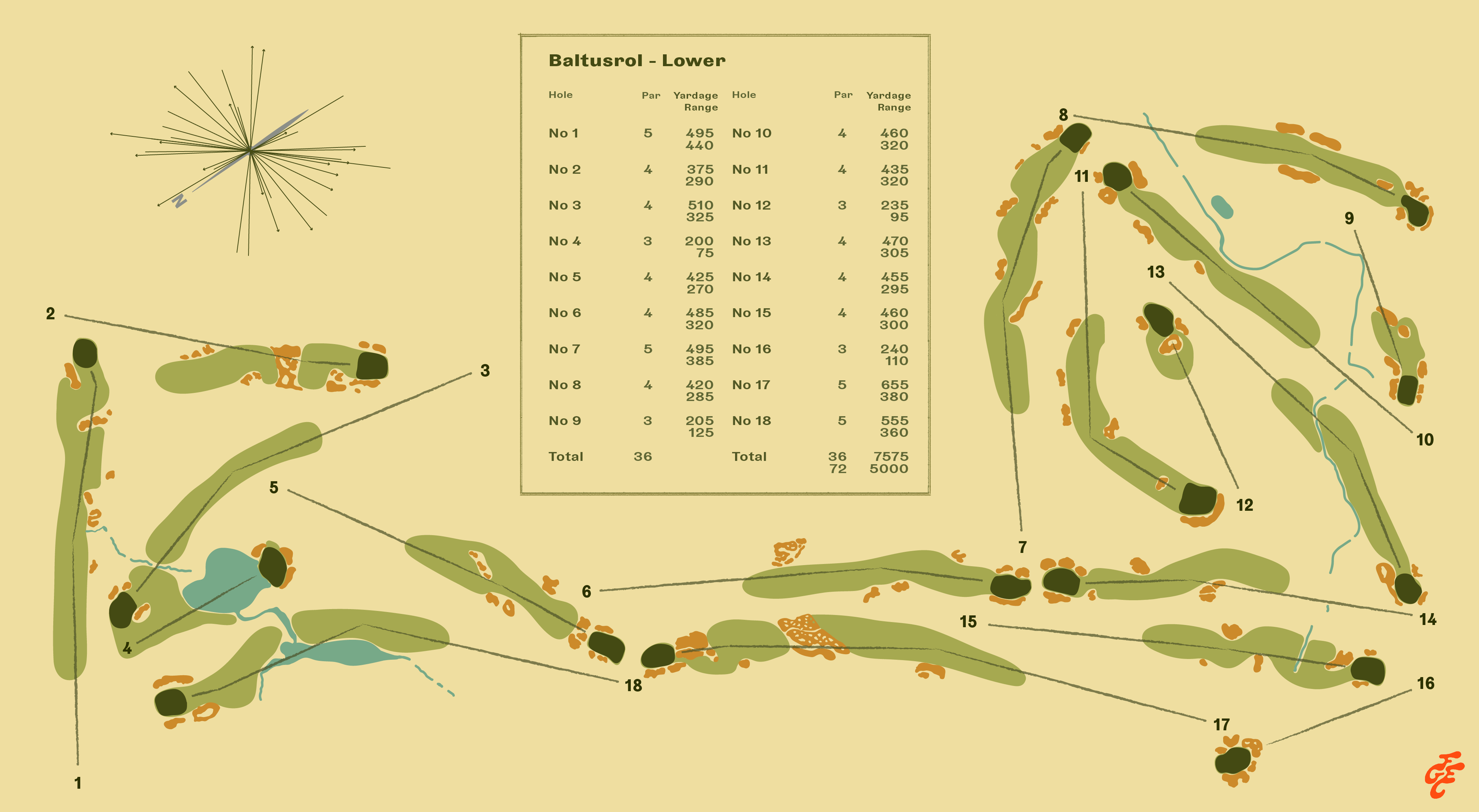Baltusrol Golf Club (Lower Course)
While a difficult test of golf, Baltusrol Lower exudes a sense of fun, with exciting risk-reward holes and inventive green designs

Springfield, New Jersey, USA
A.W. Tillinghast (original design, 1922)
Private
A.W. Tillinghast conceived of the Lower Course at Baltusrol Golf Club as part of a bold plan he presented to members in 1918. The architect’s brief was to expand Baltusrol’s original 18-hole golf course, established in the 1890s, to 36 holes. But instead of simply bolting two nines onto the existing layout, Tillinghast proposed creating two new courses—one located on the side of the ridge somewhat hyperbolically named Baltusrol Mountain (the “Upper”), and the other in the valley below (the “Lower”). Both opened in 1922 after a difficult grow-in phase. Tillinghast intended for the two courses to be equal in tournament readiness, but the Lower has ended up hosting more championships, including four U.S. Opens between 1954 and 1993.
Like other late-20th-century U.S. Open hosts, Baltusrol Lower submitted to the “Open Doctor” regimen, undergoing a series of renovations by Robert Trent Jones and, later, Rees Jones. This work gradually disconnected the course from its Tillinghast roots. After hosting a forgettable PGA Championship in 2016, the club changed tack, hiring Gil Hanse as consulting architect. Hanse restored 1920s and 30s design features at both the Lower and the Upper courses while also modernizing Baltusrol’s drainage, irrigation, and agronomic systems.
Hanse’s historical renovation of the Lower Course, unveiled in 2021, revealed a more sophisticated, less dour side of this championship venue. While still a difficult test of golf (especially from the new back tees), the Lower now exudes a sense of fun, with exciting risk-reward holes and inventive green designs.
Take Note…
Third choice. When Baltusrol Golf Club hired him in 1918, A.W. Tillinghast was not yet widely renowned as a golf architect. He had designed a handful of courses, including the outstanding Somerset Hills, but his most prominent commissions (Winged Foot, Ridgewood, Quaker Ridge) would come in the 1920s. Unsurprisingly, then, Tillinghast seems not to have been Baltusrol’s first choice. In 1917, the committee in charge of the golf course expansion initially asked the club’s board for authorization to hire Donald Ross as architect. For unknown reasons, however, the committee ended up engaging Seth Raynor instead. Raynor helped Baltusrol select land for the new holes, but by late 1918, he had been replaced by Tillinghast. Again, whatever rationale the club had for this move has been lost to history. Perhaps the fact that Tillie lived nearby in New Jersey was a point in his favor.
Big fans. Just off of several greens on the Lower and Upper courses, you will find large fans, which promote air circulation and reduce moisture on the putting surfaces. In order to hide these fans when they’re not in use, Baltusrol’s maintenance staff has developed a proprietary system involving an underground vault and a retractable mechanism. Patent pending.

Switching rotas. In spite of being a seven-time U.S. Open host, Baltusrol has apparently dropped out of the modern USGA rota. The club has not hosted the U.S. Open since 1993, and as of October 2025, it is not slated for any future USGA championships. Recently, however, Baltusrol has developed a relationship with the PGA of America, taking on hosting duties for the 2023 Women’s PGA Championship and the 2029 PGA Championship. Perhaps a Ryder Cup is in the club’s future?
{{baltusrol-lower-about-gallery}}
Favorite Hole
No. 5, par 4, 400 yards
This handsome par 4 combines strategic design with a stern physical challenge. The tee shot tests the player’s tactical wherewithal, while the approach demands a pure, strong strike.
In the Lower Course’s early years, a set of three bunkers ran on a left-to-right diagonal through the middle of the landing zone for drives. Carrying the rightmost bunker resulted in a shorter approach into the elevated, tilted, severely false-fronted green. Prior to the 2016 PGA Championship, Rees Jones restored the bunkers but placed them on the left side of the fairway, negating their strategic purpose. In his 2021 renovation, Gil Hanse moved the bunkers back to their original centerline position and widened the fairway to accommodate strategic play.
{{baltusrol-lower-fifth-hole-before-after-gallery}}l
Now the player is faced with several options from the tee: 1) attack the far bunker in pursuit of a short-iron or wedge approach, 2) stay well short of the danger and trust your mid- to long-iron game, or 3) split the difference by a) attempting to carry the closest bunker on the left or b) pushing up the right side, between the middle three bunkers and the two on the right.

{{baltusrol-lower-favorite-hole-5-gallery}}
Favorite Hole
No. 5, par 4, 400 yards
This handsome par 4 combines strategic design with a stern physical challenge. The tee shot tests the player’s tactical wherewithal, while the approach demands a pure, strong strike.
In the Lower Course’s early years, a set of three bunkers ran on a left-to-right diagonal through the middle of the landing zone for drives. Carrying the rightmost bunker resulted in a shorter approach into the elevated, tilted, severely false-fronted green. Prior to the 2016 PGA Championship, Rees Jones restored the bunkers but placed them on the left side of the fairway, negating their strategic purpose. In his 2021 renovation, Gil Hanse moved the bunkers back to their original centerline position and widened the fairway to accommodate strategic play.
{{baltusrol-lower-fifth-hole-before-after-gallery}}
Now the player is faced with several options from the tee: 1) attack the far bunker in pursuit of a short-iron or wedge approach, 2) stay well short of the danger and trust your mid- to long-iron game, or 3) split the difference by a) attempting to carry the closest bunker on the left or b) pushing up the right side, between the middle three bunkers and the two on the right.

{{baltusrol-lower-favorite-hole-5-gallery}}
Overall Thoughts
I did not have high hopes going into my first round at Baltusrol Lower earlier this year. The 2016 PGA Championship had given me the impression that the course was a bit of a slog, and the 2023 Women’s PGA Championship, held after Gil Hanse’s renovation, failed to change my mind. To my eye, the Lower looked like a straightforward, somewhat humorless test of playing ability. Many players enjoy this kind of golf. I don’t, usually.
So I was surprised to find, as my round went on, that I was having fun—and not just because golf is almost always fun. Here are four aspects of the Lower Course that caught me off guard:
1. Clever strategic design
There are two main strategic motifs at Baltusrol Lower, both effective: diagonal hazards and staggered bunkering.
Prominent diagonal hazards can be found on Nos. 2, 5 (discussed in the Favorite Hole section above), 13, and 17. In all of these cases, challenging the long end of the hazard offers a potential reward.
This concept is particularly well executed on the short par-4 second hole. Off the tee, the player must reckon with a diagonal trio of bunkers—a mirror image of the center-line hazard on the fifth hole. Clearing the long, left bunker yields a stack of advantages: a shorter approach, a better view of the green, and an angle from which the right-to-left tilt of the putting surface helps rather than hurts.

For examples of staggered bunkering, look at Nos. 1, 7, 14, and 15. On these holes, players must be precise in choosing line and distance off the tee. Those who can confidently carry a certain bunker, rather than attempting to thread the needle between bunkers, will find themselves with the most room to play on the other side.
The short par-5 seventh hole marries the Lower Course’s two motifs: it features diagonal bunkers in a staggered arrangement. The result is a complex array of strategic options—right, left, long, short. (Unfortunately, at the 2029 PGA Championship, the pros will likely bypass these options and turn No. 7 into a driver-wedge par 4. But that is a different game than most of the rest of us play.)
.jpg)
Obligatory note: the Lower Course’s strategic design would be better served by wider fairways, which would open up the full array of options Tillinghast intended. While Hanse did push out some mowing lines, he left others untouched, including those on the almost absurdly narrow third hole. No doubt the club has an eye on protecting par in future championships.
2. Varied topography
While the Upper Course sits on higher, more dramatic terrain by Baltusrol Mountain, the Lower Course, in my opinion, occupies the better property for golf. The Lower interacts with both large, broad slopes (see: the approaches to Nos. 3, 5, 15, 17, and 18)...

… and busier undulations (such as those in the sixth and eighth fairways).

This mixture of topographical scale and intensity makes for eventful, challenging golf while retaining walkability.
3. An ingenious routing
The Lower Course’s property does have a notable weakness: its shape. Long and narrow, with rectangular paddocks at both ends, the site does not lend itself to a directionally varied routing. A lesser architect might not have been able to avoid repetitive parallel holes. Tillinghast, however, managed to create continual shifts in direction. The routing of the square-shaped back paddock is especially impressive. The holes swirl around each other without a hint of repetition or linearity. Donald Ross, who worked successfully with many sites like this, would have been proud.

4. Creative green designs
While not as outrageous as Tillinghast’s greens at Winged Foot and Somerset Hills, Baltusrol Lower’s greens make up the difference with elegance and variety. The first and second greens, both sharply tilted but largely free of internal contour, may surprise players with their lay-out-the-land simplicity. As the round progresses, however, the designs become more baroque, with Tillinghast’s characteristic rolls, channels, false fronts, and sideboards gradually multiplying and growing bolder. This development culminates with the gorgeous, wavy 16th green.

To be clear, Baltusrol Lower has no chance of unseating Somerset Hills as my favorite Tillinghast course, or San Francisco Golf Club as my second favorite. I would prefer the Lower in its full Golden Age form, with broad fairways, tawny turf, and a closer connection to its natural environment. But since Baltusrol has championship aspirations, its current mowing lines and monostands will remain in place.
That said, Baltusrol Lower is the rare U.S. Open-grade venue that I wouldn’t mind playing every day.
2 Eggs
Do I wish the fairways at Baltusrol Lower were roomier, allowing for more robust strategic play? Do I think its greens are maintained at speeds that void too many interesting pin positions? Would I prefer for the presentation of the course to be more rustic and tied into the genius loci of Baltusrol Mountain? Yes, yes, and yes. But I believe an Egg rating should account for what a course is trying to do, and the Lower is trying to host modern major championships. In its current form, it is remarkably well-suited to that task, while also honoring A.W. Tillinghast’s design and providing an enjoyable experience for average golfers. That balancing act is worthy of two Eggs in my book.
Course Tour

{{baltusrol-lower-course-tour-01}}
Additional Content
Design Notebook: Gil Hanse’s Overhaul of Baltusrol (Article)
Leave a comment or start a discussion
Get full access to exclusive benefits from Fried Egg Golf
- Member-only content
- Community discussions forums
- Member-only experiences and early access to events




.jpeg)







Leave a comment or start a discussion
Lorem ipsum dolor sit amet, consectetur adipiscing elit. Suspendisse varius enim in eros elementum tristique. Duis cursus, mi quis viverra ornare, eros dolor interdum nulla, ut commodo diam libero vitae erat. Aenean faucibus nibh et justo cursus id rutrum lorem imperdiet. Nunc ut sem vitae risus tristique posuere. uis cursus, mi quis viverra ornare, eros dolor interdum nulla, ut commodo diam libero vitae erat. Aenean faucibus nibh et justo cursus id rutrum lorem imperdiet. Nunc ut sem vitae risus tristique posuere.